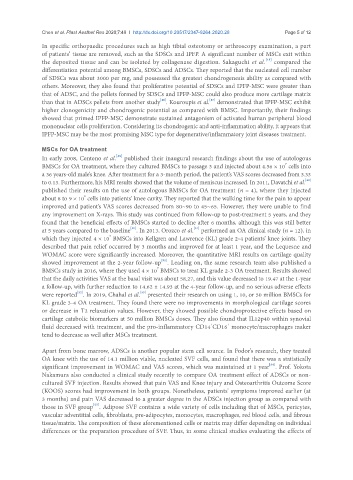Page 567 - Read Online
P. 567
Chen et al. Plast Aesthet Res 2020;7:49 I http://dx.doi.org/10.20517/2347-9264.2020.28 Page 5 of 12
In specific orthopaedic procedures such as high tibial osteotomy or arthroscopy examination, a part
of patients’ tissue are removed, such as the SDSCs and IPFP. A significant number of MSCs exit within
[45]
the deposited tissue and can be isolated by collagenase digestion. Sakaguchi et al. compared the
differentiation potential among BMSCs, SDSCs and ADSCs. They reported that the nucleated cell number
of SDSCs was about 3000 per mg, and possessed the greatest chondrogenesis ability as compared with
others. Moreover, they also found that proliferative potential of SDSCs and IPFP-MSC were greater than
that of ADSC, and the pellets formed by SDSCs and IPFP-MSC could also produce more cartilage matrix
[47]
[46]
than that in ADSCs pellets from another study . Kouroupis et al. demonstrated that IPFP-MSC exhibit
higher clonogenicity and chondrogenic potential as compared with BMSC. Importantly, their findings
showed that primed IPFP-MSC demonstrate sustained antagonism of activated human peripheral blood
mononuclear cells proliferation. Considering its chondrogenic and anti-inflammation ability, it appears that
IPFP-MSC may be the most promising MSC type for degenerative/inflammatory joint diseases treatment.
MSCs for OA treatment
[48]
In early 2008, Centeno et al. published their inaugural research findings about the use of autologous
BMSCs for OA treatment, where they cultured BMSCs to passage 3 and injected about 4.56 × 10 cells into
7
a 36 years-old male’s knee. After treatment for a 3-month period, the patient’s VAS scores decreased from 3.33
[49]
to 0.13. Furthermore, his MRI results showed that the volume of meniscus increased. In 2011, Davatchi et al.
published their results on the use of autologous BMSCs for OA treatment (n = 4), where they injected
about 8 to 9 × 10 cells into patients’ knee cavity. They reported that the walking time for the pain to appear
6
improved and patient’s VAS scores decreased from 80~90 to 45~65. However, they were unable to find
any improvement on X-rays. This study was continued from follow-up to post-treatment 5 years, and they
found that the beneficial effects of BMSCs started to decline after 6 months, although this was still better
[50]
[51]
at 5 years compared to the baseline . In 2013, Orozco et al. performed an OA clinical study (n = 12), in
7
which they injected 4 × 10 BMSCs into Kellgren and Lawrence (KL) grade 2-4 patients’ knee joints. They
described that pain relief occurred by 3 months and improved for at least 1 year, and the Lequesne and
WOMAC score were significantly increased. Moreover, the quantitative MRI results on cartilage quality
[51]
showed improvement at the 2-year follow-up . Leading on, the same research team also published a
7
BMSCs study in 2016, where they used 4 × 10 BMSCs to treat KL grade 2-3 OA treatment. Results showed
that the daily activities VAS at the basal visit was about 58.27, and this value decreased to 19.47 at the 1-year
a follow-up, with further reduction to 14.62 ± 14.93 at the 4-year follow-up, and no serious adverse effects
[52]
[53]
were reported . In 2019, Chahal et al. presented their research on using 1, 10, or 50 million BMSCs for
KL grade 3-4 OA treatment. They found there were no improvements in morphological cartilage scores
or decrease in T2 relaxation values. However, they showed possible chondroprotective effects based on
cartilage catabolic biomarkers at 50 million BMSCs doses. They also found that IL12p40 within synovial
+
fluid decreased with treatment, and the pro-inflammatory CD14 CD16 monocyte/macrophages maker
+
tend to decrease as well after MSCs treatment.
Apart from bone marrow, ADSCs is another popular stem cell source. In Fodor’s research, they treated
OA knee with the use of 14.1 million viable, nucleated SVF cells, and found that there was a statistically
[54]
significant improvement in WOMAC and VAS scores, which was maintained at 1 year . Prof. Yokota
Nakamura also conducted a clinical study recently to compare OA treatment effect of ADSCs or non-
cultured SVF injection. Results showed that pain VAS and Knee injury and Osteoarthritis Outcome Score
(KOOS) scores had improvement in both groups. Nonetheless, patients’ symptoms improved earlier (at
3 months) and pain VAS decreased to a greater degree in the ADSCs injection group as compared with
those in SVF group . Adipose SVF contains a wide variety of cells including that of MSCs, pericytes,
[55]
vascular adventitial cells, fibroblasts, pre-adipocytes, monocytes, macrophages, red blood cells, and fibrous
tissue/matrix. The composition of these aforementioned cells or matrix may differ depending on individual
differences or the preparation procedure of SVF. Thus, in some clinical studies evaluating the effects of

